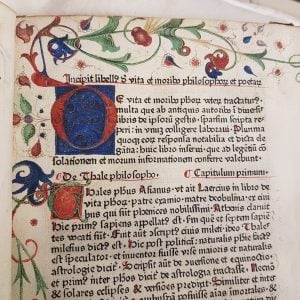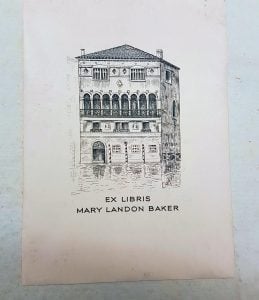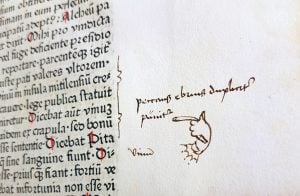What do Athena’s little owl, an unashamedly unmarried Chicago heiress, and the Heide School of modernist Australian artists have in common? A book in our collection, as it turns out…
Recently I undertook some research into the ‘incunabula’ – books printed before 1501, that is, in the first 50 years of the European printing revolution – in our Rare Books collection. This first period of printing in Europe was an exciting time of innovation and experimentation. Craftsmen and -women who had formerly been involved in the manuscript trade (goldsmiths, illuminators, scribes, book binders, etc.) began to make books in a radical new way.
The first printed books were hybrids – part print, part manuscript, and it took several centuries before hand-drawn elements were eliminated from books, as print technology gradually improved and facilitated the development of its own aesthetic.
The lives and manners of one beautiful book
One incunable in our collection caught my eye in particular because of its beautiful hand-painted opening page and colourful initial letters. I also noticed several bookplates inside the front cover that I knew would help me to learn more about this book’s provenance: tracking down the various owners of a book like this one is fun and rewarding in itself, but it can also give us important information about the origins and the condition of a book, and help us to better care for it into the future.
The book in question is an edition of the Liber de vita ac moribus philosophorum poetarum veterum (The lives and manners of the ancient philosophers and poets). It was printed in 1479 by Frederick Creussner in Nuremberg, Germany, one of the first great centres of printing.

Liber de vita ac moribus philosophorum poetarum veterum (The lives and manners of the ancient philosophers and poets). Nuremberg, 1479, printed by Frederick Creussner
The text was originally composed several hundred years earlier, possibly by the medieval English philosopher Walter Burley (c.1275–1344/45), though some scholars now consider it anonymous. Written in Latin, it recounts the lives and memorable sayings of 132 Greek and Roman philosophers, poets, historians and statesmen – the men whose intellectual and artistic achievements underpinned Western Christian medieval culture. This was a very popular work in the medieval period: 150 manuscripts of the text survive, and it was printed in 30 editions by 1530. Our edition (Nuremberg, 1479) is one of the earliest.

Detail of opening lines of the Liber de vita ac moribus philosophorum poetarum veterum (The lives and manners of the ancient philosophers and poets). Nuremberg, 1479, printed by Frederick Creussner, RARESF 093 C793.
On the first page of the text itself (after the index), someone has painted a beautiful decorative design of flowers and vines. Perched amidst the riotous colour, in the lower margin, is a small, beady-eyed owl, regarding us fiercely with claw outstretched. She surely represents Athena’s little owl – the eternal companion of the Greek goddess of wisdom (known to the Romans as Minerva). Some have suggested that the owl represents Athena because of its ability to see in the dark, an allegory of the piercing insight that wisdom brings, cutting through the darkness of ignorance.

Detail of Athena’s little owl from the Liber de vita ac moribus philosophorum poetarum veterum (The lives and manners of the ancient philosophers and poets). Nuremberg, 1479, printed by Frederick Creussner, RARESF 093 C793.
This hand-decoration would have been applied very soon after the book’s printing, possibly to the specifications of its buyer. We can never know who that individual was, nor what happened to this book over its first few centuries, but we do know about two much more recent owners, whose bookplates sit together on the inside front cover: Georg Kloss (1787–1854) and Mary Landon Baker (1901–1961).

Inside front cover, with bookplates, of the Georg Kloss’s bookplate in the Liber de vita ac moribus philosophorum poetarum veterum (The lives and manners of the ancient philosophers and poets), RARESF 093 C793.
The freemason and the free spirit
Kloss was a German historian with a special interest in freemasonry. He also collected books, and in 1835, when he inexplicably sold off his entire library, he owned no fewer than five different incunable editions of this text! However, our copy is not amongst those sold by Sotheby’s at that time: perhaps he acquired it after 1835, or perhaps he already owned it but kept it and sold it later, or perhaps he had already sold it prior to 1835 – more research is needed to determine this, though the sequence of events may never be known.

Georg Kloss’s bookplate in the Liber de vita ac moribus philosophorum poetarum veterum (The lives and manners of the ancient philosophers and poets), RARESF 093 C793.
The second owner we can identify, Mary Landon Baker, led a very different life from that of Kloss. Born in Chicago in 1901 into great wealth, she gained notoriety in the 1920s for repeatedly leaving the same man, Alister McCormick, at the altar – according to a 1956 interview with Baker in The Chicago Tribune, ‘[p]eople began using a new verb […] When someone didn’t show up at a party, he or she had “Mary Bakered”.’ Baker herself was unperturbed by her reputation as a ‘madcap Chicago heiress’:
Better refusals than divorces, at any rate… Being engaged to Alister, for me, meant my family let me stay out longer in the evenings so long as I was with him.
Baker was reported to have refused 65 (or by some accounts, 67) marriage proposals in the course of her life (presumably not all from McCormick…). The dress she nearly wore to her four planned weddings with McCormick is now held by the Chicago History Museum.

Mary Landon Baker, by Lafayette (Lafayette Ltd), half-plate nitrate negative, 3 February 1928, © National Portrait Gallery, London
Freed from the usual expectations of matrimony by her wealth, Baker lived most of her adult life in Europe, where she was known as a talented dancer and a lover of parties. As well as collecting books, she also wrote one. Appropriately, given Athena’s little owl in Baker’s copy of the Liber de vita ac moribus philosophorum poetarum veterum, her book was called Verbum sapienti, that is, ‘A word to the wise’ (Chicago, 1920). The work is a collection of Baker’s observations about life and human experience.

Mary Landon Baker’s bookplate in the Liber de vita ac moribus philosophorum poetarum veterum (The lives and manners of the ancient philosophers and poets), RARESF 093 C793.
Baker died in 1961, but she had already sold this incunable by then: from a mark in the back of the book, we know that this library purchased the book from Gino Nibbi in June 1956. This little pencil scribble brings us to the final part of question I posed at the outset of this post!

Gino Nibbi’s seller’s mark, in the Georg Kloss’s bookplate in the Liber de vita ac moribus philosophorum poetarum veterum (The lives and manners of the ancient philosophers and poets), RARESF 093 C793.
The modernist in Melbourne
Italian author, art critic and bookseller Gino Nibbi (1896–1969) emigrated to Melbourne in 1928 and opened the Leonardo Art Shop at 166 Little Collins St. He imported and sold foreign-language art books and high quality printed works by leading European Post-Impressionist and modernist artists, and developed a clientele that included many of Melbourne’s up-and-coming artists, including Arthur Boyd, John Perceval, Donald Friend, Russell Drysdale, Albert Tucker, and John and Sunday Reed (patrons of the Heidi School).[i]
With John Reed, George Bell and Adrian Lawlor, Nibbi helped found the Contemporary Art Society in 1938. He became a naturalised Australian citizen in 1939, but in 1947, when he could not renew the lease at 166 Little Collins St, Nibbi and his family returned to Italy. Setting up a new shop and art gallery in Rome, Nibbi introduced Australian modernism to European audiences: Sydney Nolan and Albert Tucker held their first European exhibitions at Nibbi’s gallery.[ii]
It is very likely that while in Rome, Nibbi acquired our incunable, after it was sold (not necessarily directly to Nibbi) by Mary Landon Baker. Nibbi returned to Australia in 1953, and for the rest of his life, lived between Melbourne, Rome and Japan. During a period in Melbourne, it seems he sold this book to this library, where it has remained ever since.

John and Sunday Reed bird-watching at Heide, taken by Albert Tucker, 1998 reprint of a photo taken in 1943, H2010.72/10
It’s hard to think of two more different characters than Georg Kloss and Mary Landon Baker, but their bookplates show that shared at least one thing in common – a love of this beautiful book. Throw in the man who brought modernist art to Australia, and took Australian modernism to the world, and this book tells us a unique and special story. By tracing this its provenance, we learn much about our own rich State collection, and can share in the passion for knowledge and beauty that has united the many caretakers – from 1479 to today – of this wonderful book.

A manicule drawn by hand in the margins of the Liber de vita ac moribus philosophorum poetarum veterum (The lives and manners of the ancient philosophers and poets), RARESF 093 C793.
[i] Desmond O’Grady, ‘Gino Nibbi (1896–1969)’, Australian Dictionary of Biography, http://adb.anu.edu.au/biography/nibbi-gino-11233. The Reeds’ personal papers are held at this library.
[ii] Lesley Harding and Kendrah Morgan, Sunday’s kitchen: food and living at Heide, Carlton, VIC, Melbourne University Publishing, 2010, p. 198.


A lovely story – thank you.
Thanks Kathy, glad you enjoyed reading it!
Excellent reading
Is the book available for public viewing?
Thanks Robyn! There’s a good chance we’ll show this book in our exhibition Mirror of the World: Books & Ideas (https://www.slv.vic.gov.au/whats-on/mirror-world-books-ideas) at some point in the future, but at the moment the book is not on display.
You can place a request to view it, like all the rare books in the collection: this involves getting in touch in person or by phone, citing the call number of the book (RARESF 093 C793) and letting us know the date and time you’d like to view it. Rare books are read in the Heritage Collections Reading Room.
If you visit the library in person, a librarian at the desk will fill in the request form for you. Alternatively, you can place your request by phone on 03 8664 7002.
You know you’ve made it when your name spawns a verb – “Mary Bakered”. What a wonderful story!
Absolutely!! I was delighted to discover that such an interesting woman owned this book, and I’m hoping to find out more about her library… To be continued!
I love it when the book becomes the history. It made me think of Geraldine Brooks amazing People of the Book.